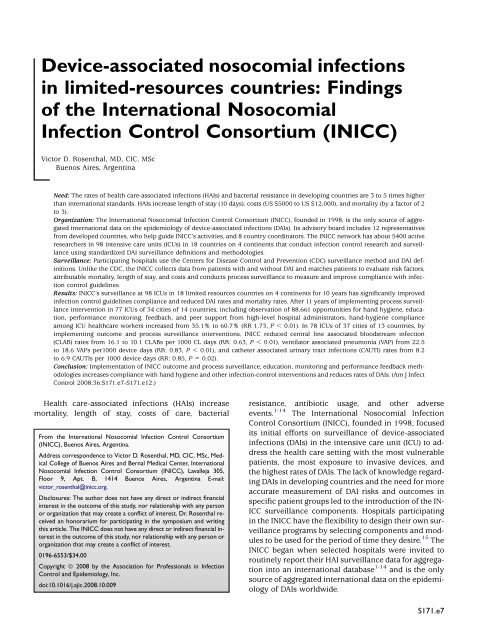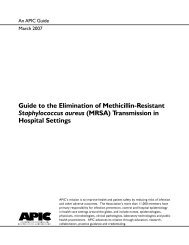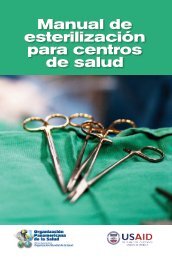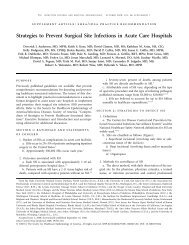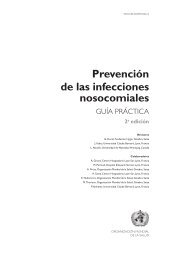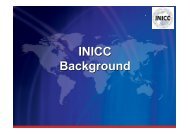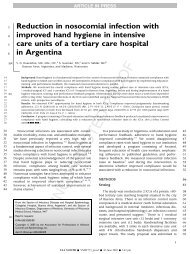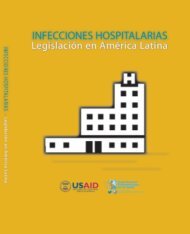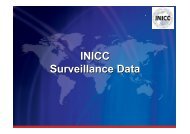Device-associated nosocomial infections in limited-resources ...
Device-associated nosocomial infections in limited-resources ...
Device-associated nosocomial infections in limited-resources ...
You also want an ePaper? Increase the reach of your titles
YUMPU automatically turns print PDFs into web optimized ePapers that Google loves.
<strong>Device</strong>-<strong>associated</strong> <strong>nosocomial</strong> <strong><strong>in</strong>fections</strong><strong>in</strong> <strong>limited</strong>-<strong>resources</strong> countries: F<strong>in</strong>d<strong>in</strong>gsof the International NosocomialInfection Control Consortium (INICC)VictorD.Rosenthal,MD,CIC,MScBuenos Aires, Argent<strong>in</strong>aNeed: The rates of health care-<strong>associated</strong> <strong><strong>in</strong>fections</strong> (HAIs) and bacterial resistance <strong>in</strong> develop<strong>in</strong>g countries are 3 to 5 times higherthan <strong>in</strong>ternational standards. HAIs <strong>in</strong>crease length of stay (10 days), costs (US $5000 to US $12,000), and mortality (by a factor of 2to 3).Organization: The International Nosocomial Infection Control Consortium (INICC), founded <strong>in</strong> 1998, is the only source of aggregated<strong>in</strong>ternational data on the epidemiology of device-<strong>associated</strong> <strong><strong>in</strong>fections</strong> (DAIs). Its advisory board <strong>in</strong>cludes 12 representativesfrom developed countries, who help guide INICC’s activities, and 8 country coord<strong>in</strong>ators. The INICC network has about 5400 activeresearchers <strong>in</strong> 98 <strong>in</strong>tensive care units (ICUs) <strong>in</strong> 18 countries on 4 cont<strong>in</strong>ents that conduct <strong>in</strong>fection control research and surveillanceus<strong>in</strong>g standardized DAI surveillance def<strong>in</strong>itions and methodologies.Surveillance: Participat<strong>in</strong>g hospitals use the Centers for Disease Control and Prevention (CDC) surveillance method and DAI def<strong>in</strong>itions.Unlike the CDC, the INICC collects data from patients with and without DAI and matches patients to evaluate risk factors,attributable mortality, length of stay, and costs and conducts process surveillance to measure and improve compliance with <strong>in</strong>fectioncontrol guidel<strong>in</strong>es.Results: INICC’s surveillance at 98 ICUs <strong>in</strong> 18 <strong>limited</strong> <strong>resources</strong> countries on 4 cont<strong>in</strong>ents for 10 years has significantly improved<strong>in</strong>fection control guidel<strong>in</strong>es compliance and reduced DAI rates and mortality rates. After 11 years of implement<strong>in</strong>g process surveillance<strong>in</strong>tervention <strong>in</strong> 77 ICUs of 34 cities of 14 countries, <strong>in</strong>clud<strong>in</strong>g observation of 88,661 opportunities for hand hygiene, education,performance monitor<strong>in</strong>g, feedback, and peer support from high-level hospital adm<strong>in</strong>istrators, hand-hygiene complianceamong ICU healthcare workers <strong>in</strong>creased from 35.1% to 60.7% (RR 1.73, P , 0.01). In 78 ICUs of 37 cities of 13 countries, byimplement<strong>in</strong>g outcome and process surveillance <strong>in</strong>terventions, INICC reduced central l<strong>in</strong>e <strong>associated</strong> bloodstream <strong>in</strong>fection(CLAB) rates from 16.1 to 10.1 CLABs per 1000 CL days (RR: 0.63, P , 0.01), ventilator <strong>associated</strong> pneumonia (VAP) from 22.5to 18.6 VAPs per1000 device days (RR: 0.83, P , 0.01), and catheter <strong>associated</strong> ur<strong>in</strong>ary tract <strong><strong>in</strong>fections</strong> (CAUTI) rates from 8.2to 6.9 CAUTIs per 1000 device days (RR: 0.85, P 5 0.02).Conclusion: Implementation of INICC outcome and process surveillance, education, monitor<strong>in</strong>g and performance feedback methodologies<strong>in</strong>creases compliance with hand hygiene and other <strong>in</strong>fection-control <strong>in</strong>terventions and reduces rates of DAIs. (Am J InfectControl 2008;36:S171.e7-S171.e12.)Health care-<strong>associated</strong> <strong><strong>in</strong>fections</strong> (HAIs) <strong>in</strong>creasemortality, length of stay, costs of care, bacterialFrom the International Nosocomial Infection Control Consortium(INICC), Buenos Aires, Argent<strong>in</strong>a.Address correspondence to Victor D. Rosenthal, MD, CIC, MSc, MedicalCollege of Buenos Aires and Bernal Medical Center, InternationalNosocomial Infection Control Consortium (INICC), Lavalleja 305,Floor 9, Apt. B, 1414 Buenos Aires, Argent<strong>in</strong>a E-mail:victor_rosenthal@<strong>in</strong>icc.org.Disclosures: The author does not have any direct or <strong>in</strong>direct f<strong>in</strong>ancial<strong>in</strong>terest <strong>in</strong> the outcome of this study, nor relationship with any personor organization that may create a conflict of <strong>in</strong>terest. Dr. Rosenthal receivedan honorarium for participat<strong>in</strong>g <strong>in</strong> the symposium and writ<strong>in</strong>gthis article. The INICC does not have any direct or <strong>in</strong>direct f<strong>in</strong>ancial <strong>in</strong>terest<strong>in</strong> the outcome of this study, nor relationship with any person ororganization that may create a conflict of <strong>in</strong>terest.0196-6553/$34.00Copyright ª 2008 by the Association for Professionals <strong>in</strong> InfectionControl and Epidemiology, Inc.doi:10.1016/j.ajic.2008.10.009resistance, antibiotic usage, and other adverseevents. 1-14 The International Nosocomial InfectionControl Consortium (INICC), founded <strong>in</strong> 1998, focusedits <strong>in</strong>itial efforts on surveillance of device-<strong>associated</strong><strong><strong>in</strong>fections</strong> (DAIs) <strong>in</strong> the <strong>in</strong>tensive care unit (ICU) to addressthe health care sett<strong>in</strong>g with the most vulnerablepatients, the most exposure to <strong>in</strong>vasive devices, andthe highest rates of DAIs. The lack of knowledge regard<strong>in</strong>gDAIs <strong>in</strong> develop<strong>in</strong>g countries and the need for moreaccurate measurement of DAI risks and outcomes <strong>in</strong>specific patient groups led to the <strong>in</strong>troduction of the IN-ICC surveillance components. Hospitals participat<strong>in</strong>g<strong>in</strong> the INICC have the flexibility to design their own surveillanceprograms by select<strong>in</strong>g components and modulesto be used for the period of time they desire. 15 TheINICC began when selected hospitals were <strong>in</strong>vited torout<strong>in</strong>ely report their HAI surveillance data for aggregation<strong>in</strong>to an <strong>in</strong>ternational database 1-14 and is the onlysource of aggregated <strong>in</strong>ternational data on the epidemiologyof DAIs worldwide.S171.e7
S171.e8 Vol. 36 No. 10 RosenthalINICCMissionThe INICC is an <strong>in</strong>ternational scientific communitythat works <strong>in</strong>teractively through a network aim<strong>in</strong>g atreduc<strong>in</strong>g HAIs. 15ValuesThe INICC considers HAIs to pose a global problemthat requires the attention of the <strong>in</strong>ternational scientificcommunity and considers that <strong>in</strong>fection controlis feasible on the basis of evidence-based medic<strong>in</strong>e;heed<strong>in</strong>g regional diversity; educat<strong>in</strong>g and provid<strong>in</strong>gthe medical community with enlighten<strong>in</strong>g <strong>in</strong>formation;and provid<strong>in</strong>g tools eligible for systematic measurement,control, and prevention. The INICCconsiders that health care safety and quality are <strong>in</strong>alienablerights of the patient and the patient’s environmentthat cannot be violated or ignored. The INICCconsiders that extra costs attributable to extra lengthof hospital stay and consumption are avoidable, and,therefore, public and hospital policies should assumeresponsibility for them. We trust the promotion of scientificresearch to f<strong>in</strong>d effective and legitimateanswers. 15VisionThe INICC vision is of a society with the m<strong>in</strong>imum<strong>in</strong>cidence of HAIs, a society that recognizes the legitimateright of a hospitalized patient to be deliveredsafe health care, and a society <strong>in</strong> which the scientificand medical community works for the safeguard ofgood <strong>in</strong>fection control and surveillance practices. 15GoalsddddThe INICC has the follow<strong>in</strong>g goals:Create a global network to conduct DAI surveillanceus<strong>in</strong>g standardized surveillance def<strong>in</strong>itions andmethodologies, promote evidence-based <strong>in</strong>fectioncontrol practices that can be used locally to preventDAIs, and to conduct <strong>in</strong>fection control research;assist hospitals and other health care organizations<strong>in</strong> develop<strong>in</strong>g surveillance methods that permittimely recognition of patient safety problems and <strong>in</strong>terventionwith appropriate control measures;provide tra<strong>in</strong><strong>in</strong>g and tools to hospitals and otherhealth care organizations to conduct outcome andprocess surveillance to measure DAIs, their consequences,and the impact of implement<strong>in</strong>g <strong>in</strong>fectioncontrol practices;improve the safety and quality of care at health carefacilities through implementation of programs to reducehealth care worker and patient DAI rates,dddddd<strong>associated</strong> mortality, lengths of stay, costs, and bacterialresistance;measure relevant trends <strong>in</strong> DAIs <strong>in</strong> hospitals globallyand facilitate <strong>in</strong>tra- and <strong>in</strong>terhospital comparisonswith risk-adjusted data that can be used for localand national quality improvement activities;tra<strong>in</strong> health care workers to improve their skills forresearch activities;support and advise <strong>in</strong>fection control personnel <strong>in</strong> <strong>in</strong>dividualhospitals on research projects;design and coord<strong>in</strong>ate prospective studies to analyzethe cl<strong>in</strong>ical impact and cost-effectiveness of provenand new low-cost <strong>in</strong>fection control <strong>in</strong>terventions;produce <strong>in</strong>novative, relevant, scientific, evidencebasedknowledge for the diagnosis, surveillance, prevention,and control of DAIs; andimprove the therapeutic and prophylactic use of anti<strong>in</strong>fectiveagents to help control antimicrobialresistance. 15ResourcesThe INICC organizational structure <strong>in</strong>cludes researchers,headquarters team (HQT), INICC country coord<strong>in</strong>ators,and INICC Advisory Board members. Theirapproximately 5400 researchers worldwide are <strong>in</strong>fectioncontrol professionals (ICPs) and hospital epidemiologists(HEs) who collect data from ICUs and send thecompleted forms to INICC headquarters <strong>in</strong> BuenosAires. The 9-person HQT supports researchers by validat<strong>in</strong>gand adjudicat<strong>in</strong>g the DAIs, enter<strong>in</strong>g the data<strong>in</strong>to specialized software, analyz<strong>in</strong>g the data, generat<strong>in</strong>gcharts, send<strong>in</strong>g charts to researchers on a monthlybasis, and answer<strong>in</strong>g queries. Approximately 30 scientificabstracts and 5 manuscripts are drafted at INICCheadquarters every year and submitted to scientificmeet<strong>in</strong>gs and peer review journals, respectively. TheINICC country coord<strong>in</strong>ators are 8 representatives andthe board members of local <strong>in</strong>fection control societies,who recruit and advise local hospitals worldwide. TheINICC Advisory Board is composed of 12 representativesfrom <strong>in</strong>fection control <strong>in</strong>ternational organizations<strong>in</strong> developed countries, who guide and advise INICC activities.INICC holds 2 meet<strong>in</strong>gs every year with thecountry coord<strong>in</strong>ators and advisory board members. 15METHODSS<strong>in</strong>ce the <strong>in</strong>ception of the INICC, participat<strong>in</strong>g hospitalshave applied the surveillance method and DAI def<strong>in</strong>itionsdeveloped by the Centers for Disease Controland Prevention (CDC), Atlanta, GA. 16-18 Unlike theCDC National Nosocomial Surveillance System (NNIS),the INICC collects data from patients with and withoutDAIs; detects risk factors; matches patients to evaluate
Rosenthal December 2008 S171.e9attributable mortality, length of stay, and costs; andconducts process surveillance to measure and improvecompliance with <strong>in</strong>fection control guidel<strong>in</strong>es.ADJUDICATIONThe CDC National Healthcare Safety Network(NHSN) <strong>in</strong> United States hospitals and the surveillancesystems implemented <strong>in</strong> several other countries useone data form to collect device-days and bed-days ofan ICU population and another form to collect datafrom patients with DAIs acquired <strong>in</strong> the ICU. INICCuses DAI adjudication to determ<strong>in</strong>e the accuracy ofthe ICPs and HEs to detect DAIs at the hospital level.For this reason, unlike the NHSN system, INICC surveillanceforms are designed to collect data from all patients,with or without DAIs. 19 Because the formsprovide an overview of what is happen<strong>in</strong>g every dayto every patient <strong>in</strong> the ICU, they cont<strong>in</strong>uously promptthe surveillance officer to suspect DAIs. Outcome surveillanceform No. 1 is used to collect daily data <strong>in</strong>clud<strong>in</strong>g(1) the patient’s temperature; (2) blood pressure, (3)exposure to <strong>in</strong>vasive devices central l<strong>in</strong>e, (4) ur<strong>in</strong>arycatheter, (5) mechanical ventilator, (6) antibiotic use,(7) cultures, and (8) presence of cl<strong>in</strong>ical pneumonia.The INICC also collects (9) culture results and (10) bacterialresistance profiles. Each month, the INICC HQTreviews all submitted forms and compares cases of suspectedDAIs with the diagnosis made by the ICPs andHEs at every participat<strong>in</strong>g hospital. INICC HQT sendsthe ICPs and HEs a list of queries concern<strong>in</strong>g the patientswith suspected <strong><strong>in</strong>fections</strong>, and the ICPs andHEs aga<strong>in</strong> review the medical charts and laboratory reportsto validate the presence or absence of suspectedDAIs. This approach is especially useful <strong>in</strong> cases <strong>in</strong>which cultures have not been done or the culture resultsare equivocal or negative, as with pneumonia orsepsis, and otherwise might not be recognized as DAIs. 15RESULTSFor 10 years, the INICC has conducted outcome andprocess surveillance at 98 ICUs <strong>in</strong> 18 develop<strong>in</strong>g countrieson 4 cont<strong>in</strong>ents. This has significantly improved<strong>in</strong>fection control guidel<strong>in</strong>es compliance, DAI rates,and mortality rates. 13Outcome surveillanceMedical-surgical ICUs. Analysis of data from medical-surgicalICUs <strong>in</strong> the INICC showed rates of 8.92catheter-<strong>associated</strong> bloodstream <strong><strong>in</strong>fections</strong> (CLABs)/1000 CL-days, 19.8 ventilator-<strong>associated</strong> pneumonia(VAP)/1000 ventilator-days, and 6.49 catheter-<strong>associated</strong>ur<strong>in</strong>ary tract <strong><strong>in</strong>fections</strong> (CAUTIs)/1000 ur<strong>in</strong>arycatheter-days. 13 The <strong>in</strong>fection rates <strong>in</strong> CDC NHSN medical-surgicalICUs published <strong>in</strong> 2007 were 2.4 CLABs/1000 CVC-days, 3.4 CAUTIs/1000 catheter-days, and3.62 VAPs/1000 ventilator-days. 19 The INICC foundthat <strong>in</strong> develop<strong>in</strong>g countries, the CR-BSI rate is 4.86times higher, the VAP rate is 5.5 times higher and,CAUTI rate 1.9 times higher than CDC NHSN rates.Coronary ICUs. In coronary ICUs of the INICC, analysisof data showed rates of 9.9 CLABs/1000 CVC-days,20.2 VAPs/1000 ventilator-days, and 6.4 CAUTIs/1000ur<strong>in</strong>ary catheter-days. 13 By comparison, <strong>in</strong> CDC NHSNcoronary ICUs, the rates were 2.8 CR-BSIs/1000 CVCdays,4.6 CAUTIs/1000 catheter-days, and 2.8 VAPs/1000 ventilator-days. 13 The INICC found that <strong>in</strong> develop<strong>in</strong>gcountries, the rate of CLABs are 3.5 times higher;VAPs are 7.2 times higher; and CAUTIs are 1.39 timeshigher than the CDC NHSN rates.Pediatric ICUs. In pediatric ICUs <strong>in</strong> the INICC, analysisof data found the follow<strong>in</strong>g rates: 6.9 CLABs/1000CVC-days, 7.98 VAPs/1000 ventilator-days, and 4.03CLABs/1000 ur<strong>in</strong>ary catheter-days. 9,18-21 In CDC-NHSN pediatric ICUs, the rates were 5.3 CLABs/1000CVC-days, 5.2 CAUTIs/1000 catheter-days, and 2.5VAPs/1000 ventilator-days. 17 The INICC found that <strong>in</strong>develop<strong>in</strong>g countries, the CLAB rate is 1.3 times higher;VAP is 3.16 times higher, and CAUTI is 0.76 times lowerthan the CDC-NHSN rates.Neonatal ICUs. In the neonatal ICUs <strong>in</strong> the INICC,analysis of data showed the follow<strong>in</strong>g rates: 15.2CLABs/1000 CVC-days, and 6.68 VAP/1000 ventilatordays.13 In the CDC NHSN neonatal ICUs (birth weight,1.500-2.500 g) showed the follow<strong>in</strong>g rates: 4.2 CLAB/1000 CVC-days and 1.1 VAP/1000 ventilator-days. 17The INICC found that <strong>in</strong> develop<strong>in</strong>g countries, theCLAB rate is 3.6 times higher and the VAP rate is 6.07times higher than the CDC NHSN rates.Resistance rates. Aggregated data from all INICCICUs showed the follow<strong>in</strong>g resistance rates: 80.8% ofall Staphylococcus aureus were methicill<strong>in</strong>-resistantStaphylococcus aureus (MRSA), 36.6% of Pseudomonasspp were resistant to imipenem, 52.4% were resistantto ciprofloxac<strong>in</strong>/ofloxac<strong>in</strong>, 56.8% of Enterobacter sppwere resistant to ceftazidime, and 68.2% of Klebsiellaspp were resistant to ceftazidime. 13 In CDC NNISICUs, the resistance rates published <strong>in</strong> 2004 showedthat 52.9% of all Staphylococcus aureus were MRSA,19.1% of Pseudomonas spp were resistant to imipenem,34.8% were resistant to ciprofloxac<strong>in</strong>/ofloxac<strong>in</strong>,27.7% of Enterobacter spp were resistant tothird-generation cephalospor<strong>in</strong>s, and 6.2% of Klebsiellaspp were resistant to third-generation cephalospor<strong>in</strong>s.20 The INICC found that MRSA was 1.52 higher,Pseudomonas spp resistance to imipenem was 1.91higher, resistance to ciprofloxac<strong>in</strong>/ofloxac<strong>in</strong> was1.45 higher, resistance of Enterobacter spp to
S171.e10 Vol. 36 No. 10 Rosenthalthird-generation cephalospor<strong>in</strong>s was 2.05 higher, andKlebsiella spp resistance to third-generation cephalospor<strong>in</strong>swas 11 higher than <strong>in</strong> CDC NNIS ICUs.Process surveillanceHand-hygiene compliance. Over the past 11 years,the INICC has collected data on 88,661 hand hygiene(HH) opportunities <strong>in</strong> 14 <strong>limited</strong> <strong>resources</strong> countries(Argent<strong>in</strong>a, Brazil, Colombia, Costa Rica, El Salvador,India, Kosovo, Nigeria, Mexico, Morocco, Pakistan,Peru, Philipp<strong>in</strong>es, and Turkey). The overall HH ratewas 54.7%. Stratified by variable, HH compliance was56.9% for women and 49.1% for men (RR 1.16, P ,0.01); 58.3% for nurses, 50.3% for physicians, and44.9% for ancillary staff (nurses vs. physicians: RR1.16, P , 0.01; nurses vs. ancillary staff: RR 1.3, P ,0.01; physicians vs. ancillary staff: RR 1.12, P , 0.01);54.2% <strong>in</strong> adult ICUs, 56.9% <strong>in</strong> pediatric ICUs, and64.6% <strong>in</strong> neonatal ICUs (neonatal vs. adult: RR 1.19,P , 0.01; neonatal vs. pediatric: RR 1.14, P , 0.01; pediatricvs. adult: RR 1.05, P , 0.12); 60.1% before <strong>in</strong>vasiveprocedure and 51.9% before non-<strong>in</strong>vasiveprocedure (RR 1.16, P , 0.01). 21Implementation of an INICC <strong>in</strong>tervention that <strong>in</strong>cludedHH observation, education, performance monitor<strong>in</strong>g,feedback, and peer support from high-levelhospital adm<strong>in</strong>istrators significantly <strong>in</strong>creased HHcompliance from 35.1% to 60.7% (RR, 1.73; P ,0.01) among ICU health care workers. 21Outcome improvementThe goal was to determ<strong>in</strong>e the effect of outcome andprocess surveillance (<strong>in</strong>tervention) on the rate of DAI <strong>in</strong>78 ICUs, of 37 cities, of 13 <strong>limited</strong> <strong>resources</strong> countries(Argent<strong>in</strong>a, Brazil, Colombia, Costa Rica, Cuba, El Salvador,India, Macedonia, Mexico, Morocco, Philipp<strong>in</strong>es,Peru, and Turkey). For CLAB and CAUTI reduction analysisthe INICC <strong>in</strong>cluded those ICUs that were <strong>in</strong> thestudy for at least 6 months, and for VAP reduction analysisthe INICC <strong>in</strong>cluded those ICUs that were <strong>in</strong> thestudy for at least 16 months. Patient’s characteristicswere similar over the two periods. CLAB rates were reducedsignificantly from 16.1 to 10.1 CLABs per 1000CL days (RR, 0.63; 95%CI, 0.57–0.70; P , 0.01). CAUTIrates were reduced significantly from 8.2 to 6.91 CAU-TIs per 1000 device days (RR, 0.85; 95%CI, 0.73–0.98;P , 0.01). VAP rates were reduced significantly from22.5 to 18.6 VAPs per 1000 device days (RR,0.83;95%CI, 0.74–0.92; P , 0.01). 22Global outcomesdINICC has successfully achieved its goals.d INICC is now an <strong>in</strong>ternational research organizationcompris<strong>in</strong>g advisory board members, country coord<strong>in</strong>ators,and researchers collect<strong>in</strong>g hospital-leveldata.d INICC has networked 5400 researchers <strong>in</strong> 98 ICUs <strong>in</strong>18 countries on 4 cont<strong>in</strong>ents, conducted surveillanceus<strong>in</strong>g standardized DAI surveillance def<strong>in</strong>itions andmethodologies, promoted evidence-based <strong>in</strong>fectioncontrolpractices used locally to prevent DAIs, andcarried out <strong>in</strong>fection-control research.d INICC has assisted hospitals and other health care organizationssuch as the World Health Organization,<strong>in</strong>fection-control societies, m<strong>in</strong>istries of health, universities,and medical colleges <strong>in</strong> develop<strong>in</strong>g surveillanceand other methods that permit timelyrecognition of patient safety problems and <strong>in</strong>terventionwith appropriate control measures.d INICC has provided tra<strong>in</strong><strong>in</strong>g and tools to 98 ICUs andother health care organizations to conduct outcomeand process surveillance to measure DAIs, their consequences,and the impact of implement<strong>in</strong>g <strong>in</strong>fectioncontrol practices.d INICC has improved the safety and quality of healthcare at health care facilities through the implementationof systematic programs to reduce DAI rates, <strong>associated</strong>mortality, excess lengths of stay and costs, andbacterial resistance.d INICC has measured relevant trends <strong>in</strong> DAIs <strong>in</strong> hospitalsaround the world and facilitated <strong>in</strong>tra- and <strong>in</strong>terhospitalcomparisons with risk-adjusted data thatcan be used for local and nationwide quality improvementactivities.d INICC has tra<strong>in</strong>ed health care workers to improvetheir skills for research activities.d INICC has supported and advised <strong>in</strong>fection controlpersonnel <strong>in</strong> <strong>in</strong>dividual hospitals on researchprojects.d INICC has conducted studies to analyze the impactand cost effectiveness of low-cost <strong>in</strong>fection control<strong>in</strong>terventions.d INICC has produced <strong>in</strong>novative, relevant, scientific,evidence-based knowledge with regard to the diagnosis,surveillance, prevention, and control of DAIs.d INICC has reduced and improved antibiotic usage tohelp control antimicrobial resistance.d INICC has published <strong>in</strong> peer review journals and presentedat scientific meet<strong>in</strong>gs previously unknownDAI rates, attributable mortality, <strong>in</strong>creased length ofstay, <strong>in</strong>creased costs, microorganism profile, and bacterialresistance.d INICC has significantly <strong>in</strong>creased HH compliance and<strong>in</strong>vasive devices care compliance.d INICC has achieved substantial reductions <strong>in</strong> DAIrates and <strong>in</strong> the morbidity and mortality <strong>associated</strong>with DAIs.
Rosenthal December 2008 S171.e11Key eventsOctober 2006: The INICC published its first Global Report<strong>in</strong> the Annals of Internal Medic<strong>in</strong>e and becamethe standard benchmark for HAI rates <strong>in</strong> develop<strong>in</strong>gcountries.February 2007: The INICC established a researchfoundation, which will conduct fundrais<strong>in</strong>g to helphospitals without <strong>resources</strong> to conduct HAI surveillanceand to f<strong>in</strong>ance INICC headquarters and new IN-ICC developments.April 2007: The INICC convenes twice-yearly meet<strong>in</strong>gswith INICC Advisory Board members and countrycoord<strong>in</strong>ators.July 2008: The INICC web page is available <strong>in</strong> English,Spanish, and Mandar<strong>in</strong>.November 2008: The INICC published its first annualreport <strong>in</strong> AJIC.November 2008: The INICC published its goals,methods, and operational procedures <strong>in</strong> AJIC.February 2009: Launch of the new onl<strong>in</strong>e softwaredatabase developed by INICC enables INICC researchersto upload data and retrieve epidemiologicand statistical <strong>in</strong>formation <strong>in</strong> the form of tables andcharts. The database enables the researchers worldwideto retrieve mathematical; epidemiologic; andstatistical analyses stratified by ICU, work shift, gender,age, severity of illness score, and many other variablesas tables, charts, and other reports.dddddddCONCLUSIONIn develop<strong>in</strong>g countries, rates of DAIs and bacterialresistance are 3 to 5 times higher than <strong>in</strong>ternationalstandards. DAIs <strong>in</strong>crease length of stay (10 days), costs(US $5000 to US $12,000), and mortality by 2-fold. Implementationof INICC process surveillance, education,and performance feedback methodologies <strong>in</strong>creasedcompliance with HH and other <strong>in</strong>fection-control <strong>in</strong>terventionsand reduced DAI rates.References1. Rosenthal VD, Guzman S, Migone O, Cr<strong>in</strong>ch CJ. The attributable cost,length of hospital stay and mortality of central l<strong>in</strong>e-<strong>associated</strong> bloodstream<strong>in</strong>fection <strong>in</strong> <strong>in</strong>tensive care departments <strong>in</strong> Argent<strong>in</strong>a: A prospective,matched analysis. Am J Infect Control 2003;31:475-80.2. Rosenthal VD, Guzman S, Orellano PW. Nosocomial <strong><strong>in</strong>fections</strong> <strong>in</strong>medical-surgical <strong>in</strong>tensive care units <strong>in</strong> Argent<strong>in</strong>a: attributable mortalityand length of stay. Am J Infect Control 2003;31:291-5.3. Rosenthal VD, Guzman S, Crnich C. <strong>Device</strong>-<strong>associated</strong> <strong>nosocomial</strong> <strong>in</strong>fectionrates <strong>in</strong> <strong>in</strong>tensive care units of Argent<strong>in</strong>a. Infect Control HospEpidemiol 2004;25:251-5.4. Rosenthal VD, Guzman S, Migone O, Safdar N. The attributable costand length of hospital stay because of <strong>nosocomial</strong> pneumonia <strong>in</strong> <strong>in</strong>tensivecare units <strong>in</strong> 3 hospitals <strong>in</strong> Argent<strong>in</strong>a: a prospective, matched analysis.Am J Infect Control 2005;33:157-61.5. Moreno CA, Rosenthal VD, Olarte N, Gomez WV, Sussmann O,Agudelo JG, et al. <strong>Device</strong>-<strong>associated</strong> <strong>in</strong>fection rate and mortality <strong>in</strong><strong>in</strong>tensive care units of 9 Colombian hospitals: f<strong>in</strong>d<strong>in</strong>gs of the InternationalNosocomial Infection Control Consortium. Infect ControlHosp Epidemiol 2006;27:349-56.6. Ramirez Barba EJ, Rosenthal VD, Higuera F, Oropeza MS, HernandazHT, Lopez MS, et al. <strong>Device</strong>-<strong>associated</strong> <strong>nosocomial</strong> <strong>in</strong>fection rates <strong>in</strong><strong>in</strong>tensive care units <strong>in</strong> four Mexican public hospitals. Am J InfectControl 2006;34:244-7.7. Rosenthal VD, Maki DG, Salomao R, Moreno CA, Mehta Y, Higuera F,et al. <strong>Device</strong>-<strong>associated</strong> <strong>nosocomial</strong> <strong>in</strong>fection <strong>in</strong> 55 <strong>in</strong>tensive care unitsof 8 develop<strong>in</strong>g countries. Ann Intern Med 2006;145:582-91.8. Mehta A, Rosenthal VD, Mehta Y, Chakravarthy M, Todi SK, Sen N,et al. <strong>Device</strong>-<strong>associated</strong> <strong>nosocomial</strong> <strong>in</strong>fection rates <strong>in</strong> <strong>in</strong>tensive careunits of seven Indian cities. F<strong>in</strong>d<strong>in</strong>gs of the International NosocomialInfection Control Consortium (INICC). J Hosp Infect 2007;67:168-74.9. Leblebicioglu H, Rosenthal VD, Arikan OA, Ozgultek<strong>in</strong> A, Yalc<strong>in</strong> AN,Koksal I, et al. <strong>Device</strong>-<strong>associated</strong> hospital-acquired <strong>in</strong>fection rates <strong>in</strong>Turkish <strong>in</strong>tensive care units. F<strong>in</strong>d<strong>in</strong>gs of the International NosocomialInfection Control Consortium (INICC). J Hosp Infect 2007;65:251-7.10. Higuera F, Rangel-Frausto MS, Rosenthal VD, Soto JM, Castanon J,Franco G, et al. Attributable cost and length of stay for patientswith central venous catheter-<strong>associated</strong> bloodstream <strong>in</strong>fection <strong>in</strong>Mexico City <strong>in</strong>tensive care units: a prospective, matched analysis.Infect Control Hosp Epidemiol 2007;28:31-5.11. Pawar M, Mehta Y, Purohit A, Trehan N, Rosenthal VD. Resistance <strong>in</strong>gram-negative bacilli <strong>in</strong> a cardiac <strong>in</strong>tensive care unit <strong>in</strong> India: risk factorsand outcome. Ann Card Anaesth 2008;11:20-6.12. Salomao R, Rosenthal VD, Gr<strong>in</strong>berg G, Nouer S, Blecher S, BuchnerFerreira SI, et al. <strong>Device</strong>-Associated Infections Rates <strong>in</strong> Critical Patientsof Brazilian Hospitals. International Nosocomial Infection ControlConsortium (INICC) F<strong>in</strong>d<strong>in</strong>gs. Pan American Journal of PublicHealth 2008;24:195-202.13. Rosenthal VD, Maki DG, Mehta A, Alvarez-Moreno C, LeblebiciogluH, Higuera F, et al. International Nosocomial Infection Control Consortiumreport, data summary for 2002-2007, issued January 2008.Am J Infect Control 2008;36:627-37.14. Cuellar LE, Fernandez-Maldonado E, Rosenthal VD, Castaneda-SabogalA, Rosales R, Mayorga-Espichan MJ, et al. <strong>Device</strong>-<strong>associated</strong> <strong>in</strong>fectionrates and mortality <strong>in</strong> <strong>in</strong>tensive care units of Peruvian hospitals:f<strong>in</strong>d<strong>in</strong>gs of the International Nosocomial Infection Control Consortium.Pan American Journal of Public Health 2008;24:16-24.15. Rosenthal VD, Maki DG, Graves N. The International Nosocomial InfectionControl Consortium (INICC): Goals and objectives, descriptionof surveillance methods, and operational activities. Am J InfectControl 2008;36:e1-e12.16. Emori TG, Culver DH, Horan TC, Jarvis WR, White JW, Olson DR,et al. National <strong>nosocomial</strong> <strong><strong>in</strong>fections</strong> surveillance system (NNIS): descriptionof surveillance methods. Am J Infect Control 1991;19:19-35.17. Garner JS, Jarvis WR, Emori TG, Horan TC, Hughes JM. CDC def<strong>in</strong>itionsfor <strong>nosocomial</strong> <strong><strong>in</strong>fections</strong>, 1988. Am J Infect Control 1988;16:128-40.18. Horan TC, Andrus M, Dudeck MA. CDC/NHSN surveillance def<strong>in</strong>itionof health care-<strong>associated</strong> <strong>in</strong>fection and criteria for specific typesof <strong><strong>in</strong>fections</strong> <strong>in</strong> the acute care sett<strong>in</strong>g. Am J Infect Control 2008;36:309-32.19. Edwards JR, Peterson KD, Andrus ML, Tolson JS, Gould<strong>in</strong>g JS, DudeckMA, et al. National Healthcare Safety Network (NHSN) Report, datasummary for 2006, issued June 2007. Am J Infect Control 2007;35:290-301.20. National Nosocomial Infections Surveillance (NNIS) System Report,data summary from January 1992 through June 2004, issued October2004. Am J Infect Control 2004;32:470-85.
S171.e12 Vol. 36 No. 10 Rosenthal21. Rosenthal VD, Angelo G, Salomao R, Barahona Guzmán N, FernándezHidalgo R, Bran de Casares AC, et al. Analysis of 88, 661 Hand HygieneOpportunities Dur<strong>in</strong>g 11 Years <strong>in</strong> 77 ICUs of 34 Cities, of 14Countries. F<strong>in</strong>d<strong>in</strong>gs of INICC. In: Proceed<strong>in</strong>gs and Abstracts of the9th Annual Meet<strong>in</strong>g of the International Federation of Infection Control;2008 October 14-17; Santiago, Chile; 2008.22. Rosenthal VD, Abouqal R, Medeiros EA, Álvarez-Moreno C, Aragón-CalzadaJM, Guanche Garcell H, et al. Impact of Outcome and Process Surveillance<strong>in</strong> Reduc<strong>in</strong>g <strong>Device</strong> Associated Infections <strong>in</strong> 78 ICUs of 37Cities of 13 Limited Resources Countries. F<strong>in</strong>d<strong>in</strong>gs of INICC. In: Proceed<strong>in</strong>gsand Abstracts of the 9th Annual Meet<strong>in</strong>g of the International Federationof Infection Control; 2008 October 14–17; Santiago, Chile; 2008.


